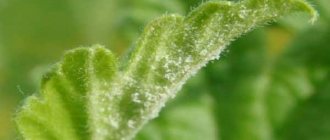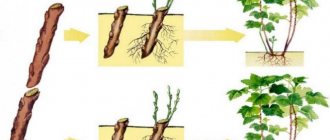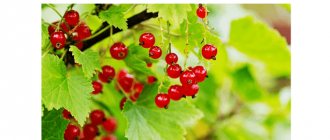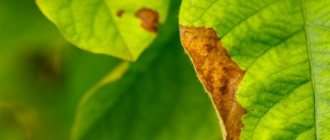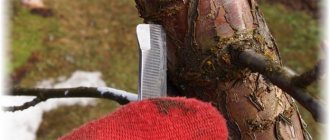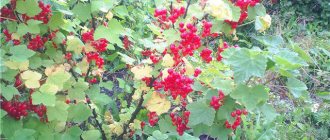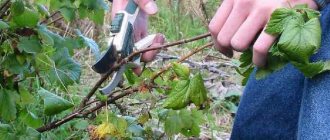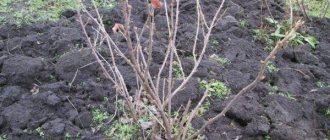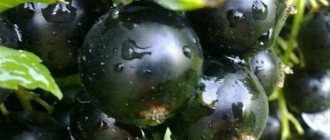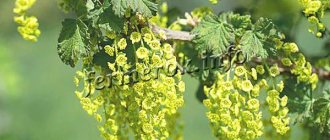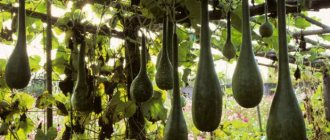Leaf marginal necrosis
The disease is non-infectious and is caused by excess chlorine in the soil. It appears towards the end of summer. A wide dry strip of ash-gray color forms along the edges of the leaves. There is a clearly defined border between this strip and healthy tissue. If such symptoms are detected in the next season, it is necessary to fertilize with urea twice (in the spring after the buds swell and after the end of flowering) (the norm is 20–30 g/m2).
If the dry strip has a darker color and its border is blurred, then this indicates potassium starvation. Accordingly, next season, at the beginning of summer, you need to add a solution of potassium monophosphate to the soil - add 20 g of fertilizer to a bucket of water and water the bushes (the norm is 20 g/m2).
Powdery mildew on currants - folk control measures
Preparations of chemical origin are effective, but they can be used a limited number of times, so many gardeners stop at folk remedies. If powdery mildew is found on currants, control measures can be as follows:
Horsetail. Combine 1 liter of water and 100 g of freshly harvested horsetail and leave for a day. Then put it on the stove and boil for a couple of hours. All that remains is to cool and strain. The finished concentrate can be stored in the refrigerator for a week. Before use, it is diluted in a ratio of 1:5. Carry out 3-4 treatments with a break of five days.
Rapeseed oil. A good folk remedy for powdery mildew on currants is prepared from 10 mg of oil per 1 liter of water
It is important to use this solution within two hours. Serum
You can cope with the fungus using a solution for which you mix part of fermented milk whey and 10 parts of water
Serum. You can cope with the fungus using a solution for which you mix part of fermented milk whey and 10 parts of water
Spray them three times every three days. As a result, a film forms on the leaves, preventing the fungi from breathing. The serum should only be used in dry weather.
Mullein. If signs of powdery mildew were found on currants, control measures may include treatment with infusion, for which take 1/3 of a bucket of cow manure and add water to the full volume. Leave it for four days and then dilute it in a ratio of 1:10. Apply in the evening to avoid burns.
Tansy. In the early stages of spring, a decoction of tansy will help, for which take 300 g of fresh grass or 30 g of dry grass, and fill it with a bucket of water. Leave for 24 hours, and then simmer over low heat for two hours. All that remains is to strain, cool and spray.
Garlic. Control measures may include the following remedy: collect half a bucket of garlic arrows or 250 g of cloves, chop everything and infuse in 10 liters of water. Afterwards, it remains to strain and process so that both sides of the leaves are moistened.
Potassium permanganate. A popular product is a product made from 0.5 teaspoons of potassium permanganate and 10 liters of water. It is recommended to carry out treatment three times every five days.
Mustard. Spraying can be done using a mustard solution, for which mix 2 tbsp. spoons of dry powder and 10 liters of hot water. When the liquid has cooled, spray.
Aspirin. Dissolve a couple of tablets in 600 ml of water, and then spray the bushes with the prepared product.
Potassium permanganate for powdery mildew on currants
Among folk remedies, potassium permanganate is popular, which is effective not only for currants, but also for grapes. It is better to use it as a preventive measure or as a control measure, but only in the early stages. Potassium permanganate against powdery mildew is taken in the amount of 1 g per 4 liters of water. Treat with the prepared solution, repeating it 2-3 times every week. The best time to use is after rain.
Iodine for powdery mildew on currants
An iodine solution helps with the fungus, for the preparation of which you should mix 1 ml of iodine, 1 liter of low-fat milk or whey. Then pour this into 9 liters of water, where you can additionally add 1 tbsp. a spoonful of liquid soap for better bonding. Apply iodine against powdery mildew on currants every 14 days until the disease completely disappears. In addition, it should be noted that this control measure will contribute to a more abundant harvest of berries.
Soda for powdery mildew on currants
You can overcome the fungus using soda ash or baking soda, for which a simple solution is prepared. Soap is also added to it so that the product adheres better to the plant.
- Soda ash for powdery mildew on currants is taken in the amount of 25 g, and it should be dissolved in 5 liters of hot water, and also add 5 g of liquid soap. Mix, cool and spray the bushes and the ground around. Repeat the procedure 2-3 times at weekly intervals.
- Baking soda is taken in the amount of 1 tbsp. spoons, and laundry soap needs 0.5 teaspoons. Mix everything thoroughly in 4 liters of water so that all ingredients dissolve, and then spray as often as in the first option. This control measure will be effective at the first signs of the disease.
Signs of defeat
- Whitish or grayish coating on currant branches and leaves. As the fungus develops, it takes on the appearance and shape of brownish-gray mold;
- A depressed growth point, which causes the development of the currant bush to stop;
- The leaves curl inward, look stubby and turn pale green;
- The ovaries fall off, the formed fruits crack and rot, and accordingly, there can be no talk of any harvest;
- The whole plant as a whole dries out and becomes weak and unstable to frost. Therefore, if the fungus does not kill the bush, it very often dies after wintering.
Powdery mildew on currants
What to do to cure currants
To treat crops from powdery mildew, they resort to spraying with chemicals, mechanical methods, and also use available folk remedies. About each of them in more detail.
Traditional methods
It is quite understandable that every gardener wants to use simple, harmless solutions for processing rather than chemicals. The most common and effective among them are the following:
- soda - 2 tablespoons of regular table soda are dissolved in 10 liters of warm, settled water;
- ash – a kilogram of dry wood ash is diluted with 10 liters of water. The resulting solution is infused for a week, filtered through gauze;
- rapeseed oil – 2 teaspoons (10 ml) of rapeseed oil are added to 10 liters of water;
- dry mustard - take 2 tablespoons of mustard into a bucket of settled rainwater;
- whey – 10 liters of water mixed with 1 liter of whey;
- boiling water - this method of processing may cause some mistrust, but it is very effective and has been tested in practice by many gardeners. Treatment of the bush with boiling water is carried out in early spring (late March-early April) before the buds open.
Important. To treat currant bushes against powdery mildew, bud mites and other pathogens that overwinter on the soil surface and shoots, metal watering cans are used that are more resistant to high temperatures. The main advantages of folk remedies over biological and chemical preparations are their following features:
The main advantages of folk remedies over biological and chemical drugs are their following features:
- low cost - all folk remedies used to combat this dangerous disease have a low cost (5-7 times lower than chemical fungicides and biological products);
- environmental friendliness - folk remedies used to combat powdery mildew do not have a negative impact on the environment, microorganisms living in the soil, and beneficial insects;
- harmlessness - thanks to the use of folk remedies that are safe for the human body, treatment with such folk remedies can be carried out even immediately before harvesting;
- ease of preparation - all folk remedies dissolve very easily in water and do not require the use of additional devices.
They are used for prevention, also when the first signs of the disease appear, but further treatment is carried out with more effective means.
Chemicals
The following fungicides are used to treat powdery mildew:
- "Topaz";
- "Acrobat";
- "Topsin-M";
- "Fundazol";
- "Bordeaux mixture";
- Copper sulfate.
Shrubs should be sprayed in dry and windless weather, observing the proportions and dosages of the drugs indicated in the instructions. The best time for chemical treatment of currants and other berry crops affected by powdery mildew is early morning or late evening. It is not recommended to treat plants with leaves damp from dew or recent rain.
After spraying the diseased currant bush with the drug, it is necessary to cultivate the ground around it.
Biological drugs
To combat powdery mildew, biofungicides are used such as:
- "Trichodermin";
- "Glyocladin";
- "Rizoplan";
- "Ftolavin";
- "Baktofit SK";
- "Alirin-B";
- "Fitosporin-M";
- "Pentaphage-S".
Compared to chemicals, biofungicides are less toxic and safer for human health, the environment, and pollinating insects (bees, bumblebees, wasps). However, the main disadvantage of these means of protection is their relatively low efficiency.
Mechanical methods
Sometimes you have to fight powdery mildew when applying chemicals to the currant bush is undesirable, for example, during the period of fruit ripening.
- if they find that the foliage or branch of a currant is covered with a white coating, then they must be torn off and removed from the bush, and then burned;
- A layer of contaminated soil is removed from around the diseased bush, treated with a fungicide, then a layer of fresh fertile soil is added under the bush.
Anthracnose
Anthracnose is a disease of black currant that can also affect vegetables and berries. The causative agent of the disease is a fungus from the class of ascomycetes. If you do not react in time, it will spread and occupy a huge area.
The weather favorable for the development of fungus is humid and warm. The disease develops more actively when there are a large number of insects, wind, lack of planting care, or damage to the bush.
Symptoms
The first manifestations of the disease can be noticed in the middle of the growing season - in late spring or early summer. The lowermost leaves are covered with brown or brown spots. Subsequently, the foliage dries out and dies. The disease affects black currant berries: dark spots appear on them, their quality deteriorates.
Treatment
Of course, it is better to prevent infection with this disease, since it is very difficult to treat. You should promptly remove fallen leaves, loosen the soil and remove weeds, and drain the planting holes. Bushes need good ventilation and an optimal amount of sun. If anthracnose has already appeared, you will have to use special preparations.
DNOC
To process currants, use 50 g of the product, diluting it in 2 liters of water. All this is mixed, and then water is added to 10 liters. Use a low concentration solution every 2-3 seasons. Too frequent treatment will destroy the plant.
Copper sulfate
A 1% solution should be prepared from 100 g of raw materials and 10 liters of water. 1.5 liters of mixture is enough for one bush. Treatment manipulations are carried out in the spring, when the buds open, and also in the fall, when the foliage has already fallen.
Bordeaux liquid
Sick currant bushes can be treated up to 5 times per season, with the first being carried out before the buds open. A solution at a concentration of 3% is suitable. For prophylaxis, a 1% solution is used.
Fitosporin
To treat the disease, 5 g of powder is diluted with 10 liters of water. Fitosporin is used at any stage of bush development, up to the formation of berries.
Ridomil Gold
It is necessary to prepare the following mixture: 25 g Ridomil + 10 liters of water. If the disease has progressed too far, increasing the amount of the drug is permissible. A maximum of 3 treatments are allowed per season: at the end of flowering, then after 2 weeks and 2 weeks before harvesting.
Fundazol
The solution is made from 15 g of Fundazol mixed with 10 liters of water. This remedy is suitable for both treatment and prevention of fungal infections.
Causes
White plaque or powdery mildew is a rather dangerous fungal disease. It appeared on Russian territory back in 1900. The disease appears in the summer, usually in the first half.
The first sign of the disease is the appearance of a white cobwebby coating on the leaves with droplets of liquid. At first, the plaque forms on the back side of the leaves, located closer to the ground, but then it covers the entire bush and moves to the shoots, buds and fruits.
Later, the plaque thickens, becomes brown, and black inclusions appear - the fruiting bodies of the causative fungus. With such damage, photosynthesis slows down significantly, and the plant stops receiving nutrients. The leaves curl, become smaller, and fall off. As a rule, the ovary also falls off along with the leaves.
In the video there is a white coating on currant leaves:
Such bushes endure winter very hard and quite often freeze out, despite protection from frost. Berries covered with plaque turn gray and lose their edibility. As a matter of fact, if the fungus has reached the berries, then you can forget about this year’s harvest. However, the plant itself can still be saved.
Plant infection
The fungus is not selective and equally affects currants, grapes, melons, pumpkins, cucumbers, and gooseberries.
The fungus tolerates cold well and overwinters on fallen leaves. So, even if the plant survives the winter, in the spring the fungus will again move to the young leaves.
The fungus multiplies very quickly, since reproduction is possible both sexually and asexually:
- asexual reproduction - white coating on the leaves - these are conidia, that is, immobile spores. They easily come off the sheet and are transferred to a new place. Thus, the currants are constantly re-infected;
- sexual reproduction - the fruiting body of the parasite can include up to a million spore bags, each of which contains from 4 to 8 ascospores. In spring, ascospores are released and infect the plant.
Conditions for the development of the fungus
Mushrooms are extremely tenacious, but develop most rapidly under certain conditions.
- Warm weather - the most favorable temperature for the development of conidia is from +5 to +28 C, although conidia form most rapidly at +20 C. Infection with ascopores occurs in the same temperature range.
- The incubation period of the disease is 5–10 days and depends on temperature. So, at +15, it takes only 5 days from infection to the maturation of conidia.
- High humidity – from 60 to 80%. Rain as such does not contribute to the development of fungus; during rainfall, the development of the disease stops. However, after rain, the soil strongly evaporates moisture, and it is in conditions of high air humidity that the fungus feels best.
In the video - how to deal with white bloom on currant leaves:
As practice shows, the most favorable conditions for the development of the disease are alternating rainy and sunny days. These conditions contribute not only to the growth of the plant, but also to its rapid infection.
- Density of planting - in this case, the distance between the bushes is too small, which significantly facilitates the transfer of spores from one plant to another. In addition, some leaves, especially low-lying ones, end up in the shade, which contributes to the development of powdery mildew.
- Excess nitrogen fertilizers - excess is the application of more than 0.6 kg per 1 acre in terms of the active component of the fertilizer. An excess of easily digestible nitrogen also contributes to the proliferation of the pathogen.
Young leaves are most susceptible to damage: literally 16–20 days after their appearance, they become victims of the disease.
Who is the causative agent
The spheroteca fungus, which survives the cold period of the year on the stems and in the apical buds of fruit bushes, under favorable conditions begins to multiply, the spores are transferred by insects and the wind to the leaves and ovaries of pumpkin crops, grapes, and gooseberries.
The pathogen reproduces with the help of conidia that fall on other shrubs, and sexually, when the spores of the parasite are released from its body in the spring.
Measures to combat powdery mildew on currants
If you detect an infestation in time and take appropriate measures, you can save the bush from death. And constant preventive work will help either avoid fungal infection altogether or minimize the harm it causes.
If the case is advanced, then it is better not to delay, but to immediately remove the entire bush, cultivate the ground around it and the plants nearby.
Processing rules
Whatever means are selected to combat powdery mildew, when using them you must adhere to the following recommendations:
It is advisable to carry out processing in cloudy weather; the bush should either be sprayed with a spray bottle or lubricated with a brush; it is important that the drug used gets on both sides of the sheet; treatment and prevention should be carried out regularly, at equal intervals of time
Ready-made drugs
They help very well against powdery mildew:
- topaz. This is the most powerful chemical drug. It is recommended for use in cases where the fungus is widespread. It is allowed to spray bushes before flowering and after harvesting;
- phytosporin. The solution is used to treat sick or possibly infected bushes in early spring. Diluted according to instructions;
Advice. Copper sulfate helps increase the effectiveness of Fitosporin. It should be taken at 80 grams. per 10 liters of finished solution.
- copper sulfate. It must be diluted in water with the addition of homemade whey in the proportions of 1 tsp. for 7 liters of water and 3 liters of whey. Can be used throughout the season. Helps preserve the berry harvest;
- Bordeaux mixture. To prepare, you need to dissolve 100 grams. honey sulfate in warm water. After dissolution, dilute with cold. It should be five liters. 100 gr. Suppress quicklime in 5 liters of water. Mix the resulting milk of lime and the vitriol mixture. Use before flowering and in the fall after harvest.
EM drugs are becoming increasingly popular. These are solutions that contain beneficial microorganisms. Once on the plant, they destroy the pathogen. In the case of powdery mildew, fungal spores are eaten. They do not act very quickly, but they are absolutely safe.
No matter how good the finished preparation for processing is, it is used mainly when growing currants on an industrial scale, or when other more loyal measures do not produce results.
Folk remedies
You can prevent the appearance of fungus, as well as defeat the fungus, using popular remedies. The following recipes are most effective against powdery mildew:
- Dilute rapeseed oil in warm water in proportions of 10 ml:10 l. After the first application, the number of spores is reduced by 200 times. If you spray a diseased bush once every three to four days, the plant will be completely healed in 15-20 days. For prevention, it is enough to carry out treatment once every 10-14 days;
- combine a kilo of ash with a bucket of water, leave for a week, stirring regularly. Then strain, add a spoonful of liquid soap (as natural as possible). Use the liquid to treat the aerial part, and place the sediment around the root;
- Dissolve 2 tablespoons of soda and grated household soap in a bucket of water. It helps if treated at the first signs of illness;
- mix 3 liters of whey and 7 liters of water. The solution is used more for prevention, but at the initial stage of the disease it is also quite effective.
How to deal with powdery mildew on currants
If the currant is covered with a white coating, it means that it is infected with a fungal infection. It is necessary to take action as quickly as possible, as the parasite multiplies quickly. Treatment is carried out chemically, mechanically or using folk remedies.
Chemicals
Fungicides are sprayed on the foliage of the bush. For currants, choose preparations marked for “garden shrubs”. These include:
- "Topaz";
- "Vectra";
- "Previkur";
- "Skor";
- "Fundazol".
Mechanical methods
Many gardeners prefer to go chemical-free. One option for removing powdery mildew is to prune all affected areas of the currant. All leaves, branches, fruits are collected in one place and then burned.
The golden mean between chemical and mechanical methods are folk remedies. People used them when no fungicides were developed. The most effective recipes:
- Mullein solution. One part of manure is mixed with three parts of water and left for 5 days. Drain the water, dilute it 3 times, spray the bushes.
- Copper sulfate. Sprinkle the powder on the currant tree trunk. Then dilute with water and spray the currants.
- Wood ash. Prepare a 10% solution. Treat the plant with a spray bottle.
- 50 g of laundry soap, 100 g of soda, pour 10 liters of water and water the affected bush.
- Add 200 g of mustard powder to 10 liters of water. Spray the foliage.
What to do? How to treat? The most important thing is not to panic. You can always find a solution to any problem, especially if you detect it in the early stages, you just need to know how to treat currants. Same with powdery mildew. There are quite effective ways to combat the disease. On the topic of how to deal with powdery mildew, how to treat this disease, there are a lot of special books and magazines that describe a huge variety of ways to get rid of white plaque.
It is important to carry out processing carefully. Shed every twig, every leaf and on both sides
When the first signs of illness appear, immediately prepare a solution of the drug: Topaz, Forecast.
At later, but not completely advanced stages of the development of the disease, biological drugs will not give a noticeable effect. So what can we do here? You can't do without chemistry. Also, the same drugs: Topaz, Impact, Copper sulfate. Multiplicity of treatments. Every 10-14 days.
Symptoms of the disease
Infection can be detected by the following signs:
- Initially, the infection spreads on the shoots and a light continuous coating appears on them, and the plant becomes infected in the same way regardless of the variety - whether the berry is red or black;
- Currant bushes become covered with a white coating; first, a cobwebby film is noticeable on the back of the leaves, then it spreads to the berries;
- As the intensity of the infection increases, the light coating will darken, and black spots will become visible on it.
After plaque appears on the shoots, the situation can be corrected by immediately starting to treat the plant. The longer it remains infected, the more the immune system will weaken. The berry plant will overwinter worse, because temperature fluctuations will be disastrous for it. All infected branches must be cut off, taken outside the site, and in order not to spread the infection to neighboring crops, they must be disposed of by burning.
Berries that are too infected are no longer suitable for eating. A heavily infected plant often dies completely. Then the bush needs to be dug up, disposed of, and the contaminated soil needs to be poured with boiling water or a solution of manganese to kill the fungus that remains in the ground.
White coating on currant leaves
Symptoms of the disease
The first sign of the disease is a white cobwebby coating on currant leaves that appears on the underside. Gradually it moves to young shoots, petioles and berries. Subsequently, the plaque thickens, turns brown and takes the form of felt with black inclusions, which are the fruiting bodies of the fungus.
Berries covered with such a coating become gray in color and become inedible. This suggests that the time to fight the disease has been lost. In this case, in the fall or early spring, it is necessary to remove and burn all infected shoots.
Powdery mildew mainly affects black currants, but infection of white and red currant bushes is possible. The disease occurs in summer, mainly in the first half, and infection most often occurs from infected gooseberries.
The most favorable conditions conducive to the appearance and development of the disease are:
- warm weather 17-28°C,
- high air humidity 90%,
- increased soil moisture,
- neglect or increased planting density,
- shaded places.
In hot, dry weather, the development of the disease slows down somewhat.
Fighting white bloom on currant leaves
The development of the disease can be prevented only at the initial stage, immediately after the appearance of a white coating on the currant bushes. To do this, you should spray infected plants with special preparations in spring or autumn, for example: Topaz, Vectra and others. Processing is carried out several times strictly according to the instructions.
To combat wintering infection, it is necessary to treat the bushes with copper sulfate. Spray the bushes in cloudy weather or in the evening, and the product should be applied to the entire leaf. Processing on hot sunny days is unacceptable.
Folk ways to combat white plaque on currant leaves
There are also folk ways to combat white bloom on currant leaves. Let's get acquainted with the most popular of them:
- Mullein or rotted hay in the amount of a third of a bucket is soaked in 3 liters of water, infused for 3 days, after which it is diluted with water in proportions 1:3. The plants are sprayed with the strained infusion. It is enough to treat the bushes 3 times: before flowering, after flowering and before leaf fall.
- 1 liter of skim milk, whey or buttermilk is diluted with 9 liters of water. The resulting mixture is treated with plants.
- An infusion of wood ash and water, in proportions of 300 g of ash and 10 liters of water. The bushes should be sprayed 2 times with an interval of 10 days. This method is used in early spring. You can also use dry wood ash. It should be applied to the tree trunk areas of the bushes.
To avoid infection, choose currant varieties that are resistant to powdery mildew, for example, Azhurnaya, Vologda, Dushystaya and others.
Why are currants affected by powdery mildew?
Currants are very often affected by American powdery mildew (sphaerotheca mors-uvae), the causative agent of which is the pathogenic fungus Sphaerotheca mors-uvae. The disease is widespread. Powdery mildew is most often found on black currants, but on red and white mycelium it can also carry out its destructive work. Spheroteka develops very quickly on bushes under certain weather conditions.
An outbreak of the disease can be facilitated by:
- violation of the planting pattern, as a result of which the bushes grow too closely;
- improper pruning that weakens the currants;
- attack by sucking pests;
- excess nitrogen in the soil;
- sudden temperature change;
- warm and humid weather.
During the fruiting period, the disease is especially dangerous, as it can completely destroy the crop.
With the arrival of warm weather in spring, the fungus begins its life cycle again. At the end of April, a new generation of spores is carried by the wind to nearby shoots and neighboring bushes. The most active phase of powdery mildew occurs in June. Usually at this time weather conditions are most favorable for the development of fungal infection. In dry weather the process fades.
White coating on currant leaves. Treatment and prevention of the disease
Even experienced gardeners periodically encounter a white coating during the growing process. This is a fungal disease called powdery mildew or oidium. If special care is not immediately provided, it completely destroys not only the berries, but also the plant itself. It is necessary to begin treatment of white plaque on currant leaves at the first symptoms of damage to the bush.
Powdery mildew is caused by erysifaceae or powdery mildew fungi. Mycelia are transferred to healthy shrubs by insects, wind and water, and are carried on garden tools or human clothing.
Optimal conditions for the development of the disease are:
- warm air temperature (15°C – 30°C);
- high humidity (60% – 80%);
- planting density (distance between bushes less than 1 m);
- excess amount of nitrogen fertilizers (more than 20 g per 1 m²).
When infected with powdery mildew, a characteristic white coating appears on currant leaves. As the disease develops, it gradually covers the branches and covers the berries of the plant. The foliage turns gray with brown or brown spots. The affected young shoots do not develop and are deformed, and the leaves curl, dry out and subsequently fall off.
Fungal spores do not die at low temperatures; they persist on fallen leaves and soil, multiply quickly and lead to the death of the plant in a few years.
Treatment of powdery mildew
Depending on the stage of development of the fungus and the degree of damage to the currant, plaque can be combated using chemicals, folk remedies and mechanical treatment.
Mechanical methods of combating the disease include:
- planting bushes growing too close to each other;
- replacing the top layer of soil under the affected plant;
- regular weeding;
- pruning damaged branches and removing affected foliage.
Chemical treatment consists of spraying the infected currant bush with fungicides. For protection and treatment, drugs such as:
Using pesticides, you can preserve the plant even with a high degree of disease development.
Folk remedies are effective at the early stage of currant damage. Most often, when a white coating is detected on the leaves, the bushes are treated with solutions of:
- copper sulfate and salt;
- potassium permanganate (potassium permanganate);
- soda ash and crushed laundry soap;
- wood ash.
This treatment is less effective compared to spraying with chemicals, but does not harm the health of the plant and humans.
Prevention of currant disease with powdery mildew
Comprehensive prevention helps protect currant bushes from infection with powdery mildew. In order to protect the plant you need:
- disinfect seedlings before planting using preparations that contain copper;
- destroy damaged shoots;
- in the spring, dig up the soil and remove overwintered leaves;
- water the currants in the first half of the day and only after the top layer of soil has completely dried;
- treat garden tools with disinfectants;
- apply fertilizers containing potassium and phosphorus to the soil;
- Carry out scheduled spraying of currants (it is better to treat the bushes using traditional methods).
To detect the appearance of fungus in the early stages, plants must be periodically inspected. In addition, by choosing varieties for planting that are resistant to powdery mildew, you can reduce the risk of disease already at the time of purchasing planting material.
Resistant varieties
Every gardener wants to have a currant variety with excellent taste, good yield, and, of course, high resistance to diseases, in particular powdery mildew. Here are some varieties:
- "Charm";
- "Ilya Muromets";
- "Titania"
- "Summer resident";
- "Selechenskaya";
- "Ceres".
These varieties are highly resistant not only to powdery mildew, but also to many other fungal diseases of currants.
Charm
